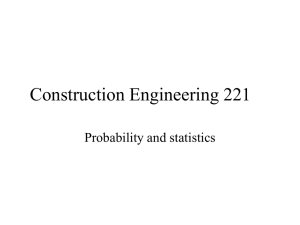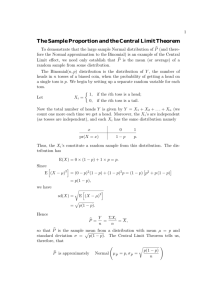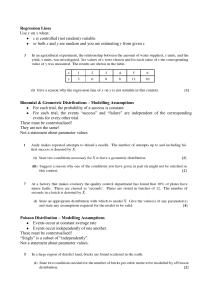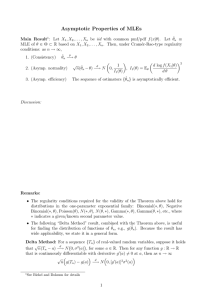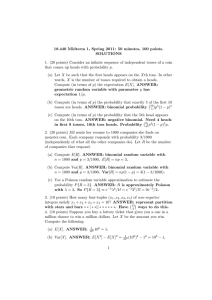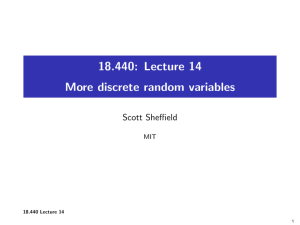The geometric distribution
advertisement
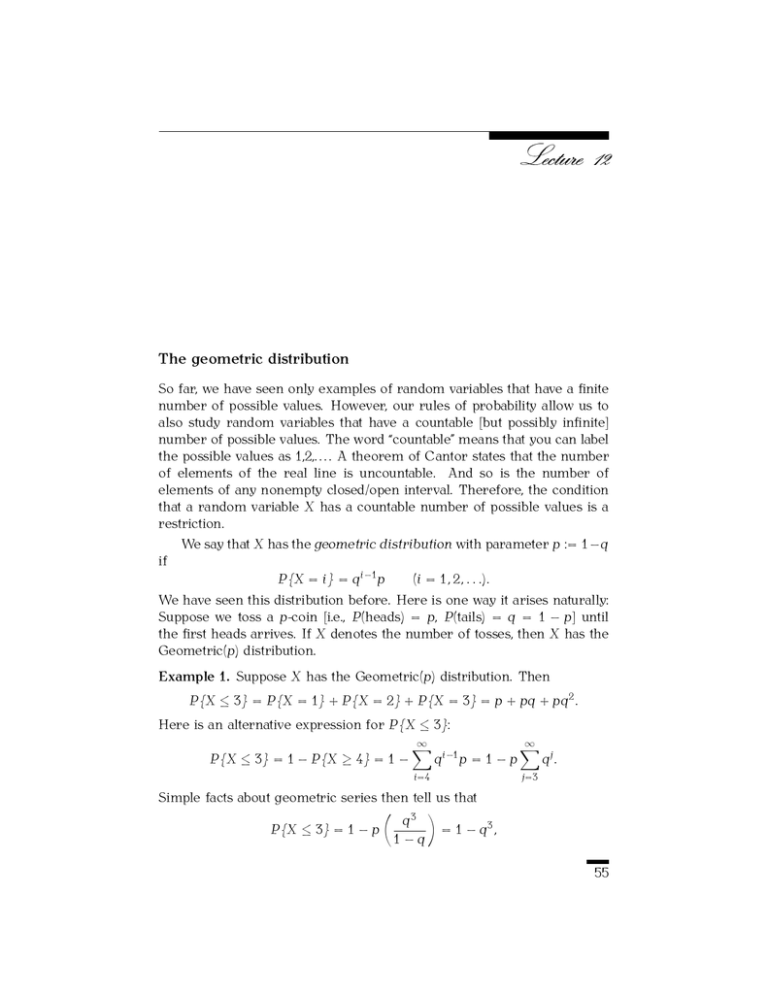
The geometric distribution
So far, we have seen only examples of random variables that have a finite
number of possible values. However, our rules of probability allow us to
also study random variables that have a countable [but possibly infinite]
number of possible values. The word “countable” means that you can label
the possible values as 1,2,. . . . A theorem of Cantor states that the number
of elements of the real line is uncountable. And so is the number of
elements of any nonempty closed/open interval. Therefore, the condition
that a random variable X has a countable number of possible values is a
restriction.
if
We say that X has the geometric distribution with parameter p := 1−q
P{X = i} = q i−1 p
(i = 1, 2, . . .).
We have seen this distribution before. Here is one way it arises naturally:
Suppose we toss a p-coin [i.e., P(heads) = p, P(tails) = q = 1 − p] until
the first heads arrives. If X denotes the number of tosses, then X has the
Geometric(p) distribution.
Example 1. Suppose X has the Geometric(p) distribution. Then
P{X ≤ 3} = P{X = 1} + P{X = 2} + P{X = 3} = p + pq + pq 2 .
Here is an alternative expression for P{X ≤ 3}:
P{X ≤ 3} = 1 − P{X ≥ 4} = 1 −
∞
!
i=4
q
i−1
p =1−p
Simple facts about geometric series then tell us that
" 3 #
q
= 1 − q 3,
P{X ≤ 3} = 1 − p
1−q
∞
!
j=3
qj .
55
56
12
since p = 1 − q. More generally, if k is a positive integer ≥ 1, then
"
#
k
k
k−1
!
!
!
1 − qk
i−1
i−1
j
P{X ≤ k} =
q p=p
q
=p
q =p
= 1 − qk,
1−q
i=1
i=1
since p = 1 − q.
j=0
Example 2. What is E(X) when X has the Geometric(p) distribution? Well,
clearly,
∞
∞
!
!
i−1
E(X) =
iq p = p
iq i−1 .
i=1
i=1
d i
How can we calculate this? Note that
= dq
q . Therefore a standard
fact from calculus [term-by-term differentiation of an infinite series] tells
us that
"
#
"
#
∞
∞
d ! i
d ! i
d
1
1
1
E(X) = p
q =p
q =p
=p
= .
2
dq
dq
dq 1 − q
p
(1 − q)
i=1
iq i−1
i=0
Note that we benefited greatly from studying the problem for a general
variable p [as opposed to p = 1/2, say, or some such choice]. In this way,
we were able to use the rules of calculus in order to obtain the answer.
Example 3. What is Var(X) when X has the Geometric(p) distribution? We
know that E(X) = 1/p. Therefore, it suffices to compute E(X 2 ). But
2
E(X ) =
∞
!
i=1
iq
i−1
p=p
∞
!
i=1
i2 q i−1 .
In order to compute this we can write the sum as
∞
∞
∞
!
!
!
2 i−1
i−1
i q
=
i(i − 1)q
+
iq i−1 .
i=1
We saw earlier that
Similarly,
∞
!
i=1
Therefore,
i(i − 1)q
$∞
i=1
∞
!
i=1
i−1
i2 q i−1
i=1
iq
=q
=
i−1
∞
!
i=1
2qp−3
2q
1
2−p
+ =
p
p2
p2
√
Equivalently, SD(X) = q/p.
E(X 2 ) =
i=1
∞
d ! i
1
=
q = 2.
dq
p
i=0
i(i − 1)q
+
p−2 ,
%
i−2
∞
d2 ! i
2q
=q 2
q = 3.
dq
p
and hence
Var(X) =
i=0
2−p
1
q
− 2 = 2.
p2
p
p
The Poisson distribution
57
The negative binomial distribution
The negative binomial distribution is a generalization of the geometric
[and not the binomial, as the name might suggest]. Let us fix an integer
r ≥ 1; then we toss a p-coin until the rth heads occur. Let Xr denote the
total number of tosses.
Example 4 (The negative binomial distribution). What is the distribution
of Xr ? First of all, the possible values of Xr are r, r + 1, r + 2, . . . . Now
for all integers n ≥ r,
P{Xr = n} = P {The first n − 1 tosses have r − 1 heads, and the nth toss is heads} .
Therefore,
P{Xr = n} =
"
#
"
#
n − 1 r−1 (n−1)−(r−1)
n − 1 r n−r
p q
×p =
p q
r−1
r−1
(n ≥ r).
This looks a little bit like a binomial probability, except the variable of
the mass function is n. This distribution is called the negative binomial
distribution with parameters (r , p).
Example 5. Compute E(Xr ) and Var(Xr ). Let G1 denote the number of
tosses required to obtain the first heads. Then define G2 to be the number of additional tosses required to obtain the next heads . . . Gr to be
the number of additional tosses required to obtain the next [and rth]
head. Then, G1 , G2 , . . . , Gn are independent random variables each with
the Geomteric(p) distribution. Moreover,
Therefore,
Xr = G1 + · · · + Gr .
E(Xr ) = E(G1 ) + · · · + E(Gr ) =
Var(Xr ) = Var(G1 ) + · · · + Var(Gr ) =
The Poisson distribution
rq
p2
r
,
p
%
and
SD(Xr ) =
√
rq
.
p
We say that a random variable X has the Poisson distribution with parameter λ > 0 when
e−λ λ k
for k = 0, 1, 2, . . . .
k!
Two questions arise: First, is the preceding a well-defined probability distribution? And second, why this particular form?
P{X = k} =
58
In order to answer the first question we have to prove that
1. But the Taylor’s expansion of f(x) = ex tells us that
eλ =
Divide by eλ in order to find that
∞
!
λk
k=0
$∞
k!
.
k=0 P{X
$∞
k=0 e
12
−λ λ k /k!
= k} = 1, as one would like.
The next proposition [the law of rare events] shows how the Poisson
distribution can be viewed as an approximation to the Binomial distribution
when p ∝ 1/n.
Proposition 1 (Poisson). Suppose λ is a positive constant that does not
depend on n. If X has the Binomial distribution with parameters n and
λ/n, then
e−λ λ k
for all k = 0, . . . , n,
P{X = k} ≈
k!
provided that n is large.
Proof. The exact expression we want follows: For all k = 0, . . . , n,
" # " #k "
#
n
λ
λ n−k
P{X = k} =
1−
k
n
n
" # "
#
n(n − 1) · · · (n − k + 1) λ k
λ n−k
=
1−
.
k!
n
n
Because k is held fixed, we have n(n − 1) · · · (n − k + 1) ≈ nk as n → ∞.
Therefore,
"
#
"
#
λ n−k
λ n
1 k
1 k
P{X = k} ≈ λ 1 −
≈ λ 1−
,
k!
n
k!
n
since (1 − nλ )k → 1 as n → ∞ [again because k is fixed]. It suffices to prove
that
"
#
λ n
1−
≈ e−λ
as n → ∞.
n
Equivalently,
"
#
λ
n ln 1 −
≈ −λ
as n → ∞.
n
But this is clear because
ln(1 − x) ≈ 1 − x
if x ≈ 0,
thanks to the Taylor expansion of ln(1 − x).
!
Now because Poisson(λ) is approximately Binomial (n , λ/n), one might
imagine that the expectation of a Poisson(λ) is approximately the expectation of Binomial (n , λ/n) which is nλ/n = λ. And that the variance of
=
The Poisson distribution
59
a Poisson(λ) is approximately the variance of Binomial (n , λ/n) which is
n(λ/n)(1 − nλ ) ≈ λ. Although the preceding “argument” is logically flawed,
it does produced the correct answers.
Let X have the Poisson(λ) distribution. In order to compute E(X) we
proceed as follows:
∞
∞
∞
!
!
!
e−λ λ k
e−λ λ k
e−λ λ k
EX =
k
=
k
=
k!
k!
(k − 1)!
Similarly,
2
E(X ) =
Now
=
k=0
∞
!
e−λ λ j+1
=
∞
!
k=0
∞
!
k=1
∞
!
k=1
k
2e
j=0
−λ λ k
k!
k(k − 1)
k(k − 1)
Consequently,
j!
=
∞
!
k=1
e−λ λ k
k!
k
k=1
= λe−λ
2e
+λ
−λ λ k
k!
=
∞
!
λj
j=0
∞
!
k=1
j!
k=1
= λ.
∞
e−λ λ k ! e−λ λ k
k(k − 1)
+
k
k!
k!
k=1
[from the computation for EX].
∞
!
e−λ λ k
λ k−2
= e−λ λ 2
k(k − 1)
k!
k!
E(X 2 ) = λ 2 + λ
=e
%
k=1
∞
2
d2 ! λ k
−λ 2 d
λ
=
e
λ
eλ = λ2 .
k!
dλ 2
dλ 2
−λ 2
k=1
Var(X) = λ
⇔
SD(X) =
√
λ.
Theorem 1 (A central limit theorem). Let Xλ have a Poisson distribution
with parameter λ. Then the standardization of Xλ has approximately a
standard normal distribution. That is, for all −∞ ≤ a ≤ b ≤ ∞,
%
&
Xλ − λ
P a≤ √
≤ b ≈ Φ(b) − Φ(a)
when λ is large.
λ

